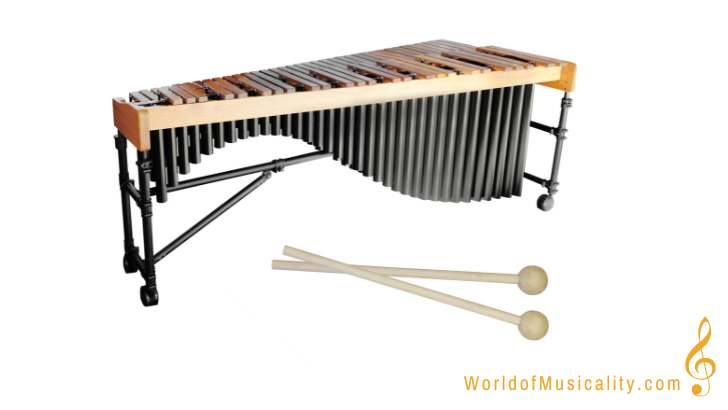
What is a Xylophone Instrument?
The xylophone is a percussion instrument known for its bright and resonant sound, produced by striking wooden bars with mallets.
It features a series of tuned wooden bars of varying lengths, arranged similarly to a piano keyboard.
Xylophones are widely used in orchestras, bands, solo performances, and educational settings.
Detailed Instrument Description
| Instrument Name | Xylophone |
| Instrument Family | Percussion |
| Alternative Names | The xylophone is known by the same name in many languages, though in some regions, it may be called “xylofon” (Swedish) or “xilófono” (Spanish). |
| Geographical Presence | The xylophone is played worldwide, being a fundamental part of Western classical music traditions, as well as in African, Asian, and Latin American music. It is a staple in symphony orchestras, concert bands, solo performances, and educational music programs. |
| Instrument Classification | The xylophone falls under the Hornbostel-Sachs classification system as 111.212, identifying it as a percussion idiophone with tuned bars. This system classifies musical instruments based on how they produce sound, with the xylophone classified as an idiophone where sound is produced by the material of the instrument itself vibrating. |
| Unique Features | The xylophone is known for its bright, resonant sound and the use of wooden bars. The bars are arranged in a similar layout to a piano keyboard and are struck with mallets to produce sound. Xylophones often include resonator tubes beneath the bars to enhance their sound. |
| Sound Characteristics | The xylophone produces a bright, sharp, and penetrating sound. Its tone is clear and resonant, making it ideal for melodic and rhythmic roles in various musical settings. The instrument can produce both rapid, intricate passages and powerful, dynamic expressions. |
| Typical Music Genres | The xylophone is used in classical music, including orchestral and band repertoire, as well as in solo performances. It is also prominent in traditional African, Asian, and Latin American music, as well as in contemporary and popular music. |
| Components | Wooden Bars, Frame, Resonators, Mallets |
| Construction | The xylophone is traditionally made with wooden bars, often of rosewood or synthetic materials, arranged on a frame. The bars are of varying lengths, which determine their pitch. Resonator tubes, usually made of metal, are placed beneath the bars to amplify the sound. The instrument is played with mallets, which can have heads made of various materials such as rubber, plastic, or wood. |
| Size and Weight | The size of the xylophone can vary, typically ranging from 1 to 1.5 meters (3 to 5 feet) in length. The weight varies depending on the size and materials used, generally between 10 to 30 kilograms (22 to 66 pounds). |
| Variations and Customizations | Variations of the xylophone include different ranges (soprano, alto, bass), materials for bars (wood or synthetic), and the addition of resonators. Customizations might include different types of mallets for varied sound quality, adjustable frames, and decorative elements. |
| Instrument History | The xylophone has ancient origins, with early versions found in Africa and Asia. It was introduced to Europe in the 16th century and evolved into the modern orchestral xylophone by the 19th century. Composers like Saint-Saëns and Orff significantly expanded its use in Western classical music. |
| Similar Types of Instrument | Marimba, Vibraphone, Glockenspiel |
| Playing Technique | The player strikes the wooden bars with mallets to produce sound. Different mallets can be used to achieve various tones and dynamics. Proper technique involves controlling the mallet’s rebound and using wrist and arm movements to play rapidly and accurately. |
| Notable Composers | Camille Saint-Saëns, Carl Orff, Igor Stravinsky |
| Famous Works | Saint-Saëns’ “Danse Macabre,” Orff’s “Carmina Burana,” Stravinsky’s “The Rite of Spring” |
| Maintenance | Regular maintenance includes dusting the bars, checking and tuning the resonators, and occasionally replacing worn mallet heads. The xylophone should be stored in a case or covered when not in use to protect it from dust and damage. |
| Learning Difficulty | Moderate to high; requires coordination and dexterity to manage the mallets and play accurately. Learning proper striking techniques, mallet control, and music reading are essential for effective playing. |
| Prominent Players | Evelyn Glennie, Keiko Abe, George Hamilton Green |
| Notable Performances | Notable performances include concerts by prominent xylophonists at major venues and festivals worldwide, such as the Percussive Arts Society International Convention (PASIC). |
| Famous Orchestras/Bands | Prominent ensembles featuring the xylophone include the Berlin Philharmonic, the New York Philharmonic, and the Los Angeles Philharmonic. |
| Xylophone Price Range | Xylophones range from $500 to $5,000 or more, depending on the craftsmanship, materials, and features. Beginner models start around $500, while professional models with custom features can exceed $5,000. |
| Interesting Instrument Facts | 1. The xylophone is one of the oldest known musical instruments, with origins dating back to ancient Africa and Asia. 2. It is used in a variety of musical genres, from classical to popular music. 3. The xylophone’s bright sound can cut through an orchestra, making it a prominent melodic and rhythmic instrument. 4. Some xylophones have resonators tuned to specific frequencies to enhance their sound. 5. The xylophone is often used in music education due to its straightforward playing technique and clear pitch. |







